You might find this hard to believe but
Ninja Village, the latest release from Kairosoft, has ninjas in it. Oh yes.
But that's not all. It also has epic shogun battles, village management, training runs, archery. But yes. Mainly ninjas.
In this here guide for
Ninja Village, I shall bestow a number of tips and tricks for your bedtime reading, which should help you to overthrow those evil ninja overlords.
To battle!
Who goes first?Let's focus on the battles first. In these fights, each type of unit has its own specific use, and will fire off its weapon in order with the rest of your troops.
Gunners go first, blasting shells into the opponent's infantry. Once the infantry are dead, their bullets will then hit enemy gunners, then archers, and finally cavalry.
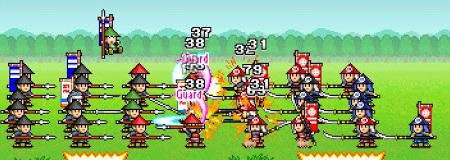
Archers go next, spraying their arrows over enemy archers and gunners (infantry and cavalry will get knocked around slightly too).
Then it's infantry, who rush into battle and take out enemy infantry, then gunners, then archers, then cavalry. Finally, the cavalry pelt forward and do damage to whoever is in front, dealing serious damage to themselves in the process.
Make sure you know this ordering off by heart, because it will come in useful for the next section of this guide.
Using your units to your advantage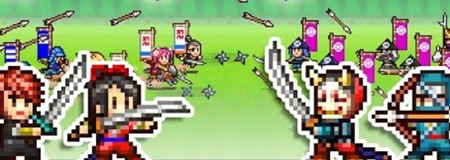
You can use the above ordering to know which types of troops you need to bolster.
For example, if you're finding that the enemy always has infantry left over and this causes a draw, then what you need is more gunners. Gunners will quickly clear the infantry out and allow your own infantry to push forward more quickly.
Meanwhile, if the enemy is destroying you with their archers, you need more archers yourself.
One thing to note is that cavalry is meant as a very throwaway unit. Since it only attacks at the end of a turn, and ends up hurting itself a lot, it can be used as a sort of last resort "screw you" to enemy infantry.
However, if you can build up your cavalry numbers to sizable proportions, they can become a force to be reckoned with. Cavalry in large numbers are far more powerful, and don't lose as many units in the rush.
Knowing where to attack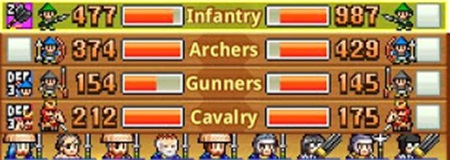
The numbers that you find next to your troops at the bottom of a screen during a battle don't mean a huge amount, and you basically end up having to work out on your own who you should attack, and who you should hold off on.
The training ground is useful for this. If you keep having a crack at the training levels until you can't beat them anymore, then you can look at the values of the training team that beat you, and compare them to the surrounding fortresses.
This will then give you a clear indication of which teams you're likely to beat, and which you still need to rally more troops for.
Smaller encounters are a different kettle of fish altogether, such as when you're attacked by bears or crows, and often you just need to head into those battles, hope for the best, and then bolster your team if it turns out you're not strong enough.
Of course, for these encounters, you'll need to train your individual ninjas to higher levels, rather than focusing on building up your main shogun army.
In the village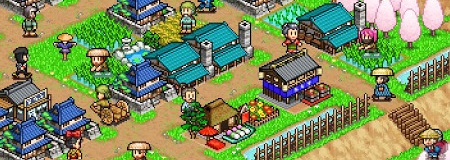
The layout of your village is pretty simple, if you follow some basic steps.
For each shop that you place, you really need to place a factory to go with it. For each factory, you need at least two sources of materials (fields, lumber yards, etc).
When it comes to stocking the shops, start with the least expensive items, and work your way up slowly.
Set one shop to a slightly more expensive stock, and wait until that gets to the point where it isn't selling out. Then set another to the higher up stock, and so on and so forth.
Spread your shops and homes out too. That way your ninjas will be able to share the load and not have to walk as far to get to work, therefore increasing the amount of stock that you get in more quickly.
One final thought - remember that ninjas can use houses as pathways, and can walk through each others' houses. This means you can potentially put houses behind other ones, and use up some of that wasted space.







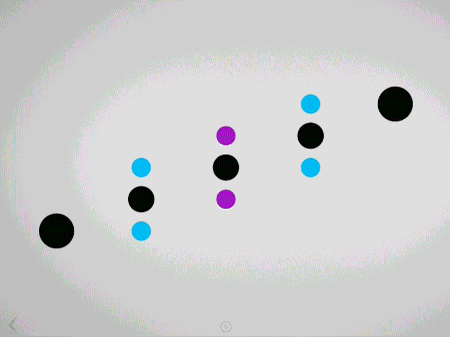


 What’s Behind? Swipe and Guess Answers Level 121-140
What’s Behind? Swipe and Guess Answers Level 121-140 Logo Quiz – English Answers Level 51-100
Logo Quiz – English Answers Level 51-100 Emoji Words Level 1-20 Answers and Solutions
Emoji Words Level 1-20 Answers and Solutions Dimensional Drift Cheats, Guide & Tips - AppGameCheats.com
Dimensional Drift Cheats, Guide & Tips - AppGameCheats.com Infinite Pics 90s Pack Levels 0-99 Answers
Infinite Pics 90s Pack Levels 0-99 Answers